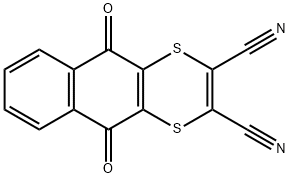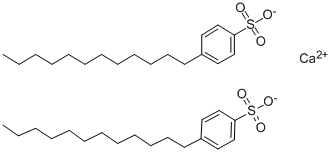Dodine
Synonym(s):1-Dodecyl-guanidiniumacetat
- CAS NO.:2439-10-3
- Empirical Formula: C15H33N3O2
- Molecular Weight: 287.44
- MDL number: MFCD00034998
- EINECS: 219-459-5
- SAFETY DATA SHEET (SDS)
- Update Date: 2025-01-27 09:38:02

What is Dodine?
Chemical properties
White Solid
The Uses of Dodine
Dodine is used to control scab on apples, pears and pecans, leaf spot diseases of cherries, olives, blackcurrants, celery and other crops, and foliar diseases of strawberries. It is also used on other fruit, vegetable, nut and ornamental crops and shade trees.
The Uses of Dodine
Used as agricultural fungicide.
What are the applications of Application
Dodin is an agricultural fungicide
Definition
ChEBI: An acetate salt resulting from the reaction of equimolar amounts of 1-dodecylguanidine and acetic acid. It is used as a fungicide to control black spot and foliar diseases on apples, pears, peaches, nectarines and strawberries.
General Description
White crystalline solid. Used as a fungicide.
Air & Water Reactions
Soluble in hot water.
Reactivity Profile
Acidic organic/inorganic salts, such as Dodine, are generally soluble in water. The resulting solutions contain moderate to high concentrations of hydrogen ions and have pH's of less than 7.0. They react as acids to neutralize bases. These neutralizations generate heat, but less or far less than is generated by neutralization of inorganic acids, inorganic oxoacids, and carboxylic acid. They usually do not react as either oxidizing agents or reducing agents but such behavior is not impossible. Many of these compounds catalyze organic reactions.
Agricultural Uses
Fungicide, Microbiocide: Used to control black spot on apples, pears and pecans; brown rot and foliar diseases on peaches and nectarines, cherries, strawberries, black walnuts and sycamore trees. In industry, used as a biocide and preservative. May also be used to catalyze organic reactions.
Trade name
AC 5223®; AMERICAN CYANAMID® 5223; APADODINE®; CARPENE®; CURITAN®; CYPREX®; CYPREX® 65W; CYTOX® 2160; DOQUADINE®; EFUZIN®; KARPEN®; MELPREX®; MELPREX® 65; MILPREX®; QUESTURAN®; Radspor L; SULGEN®; SYLLIT®; SYLLIT® 65; SYLLIT® 400SC, TEBULAN®; TSITREX®; VANDODINE®; VENTUROL®; VONDODINE®
Metabolic pathway
No information is available on the fate of dodine in soils but in plants it is converted into creatine by the action of a methyltransferase, and simultaneously the dodecyl moiety is oxidatively cleaved (PM).
Degradation
Dodine is stable in neutral and moderately alkaline or acidic media but the free base is liberated by concentrated alkali (PM).
Properties of Dodine
| Melting point: | 136°C |
| Boiling point: | 429.73°C (rough estimate) |
| Density | 0.9636 (rough estimate) |
| vapor pressure | 5 x 10-6 Pa (20 °C, est.) |
| refractive index | 1.6500 (estimate) |
| Flash point: | >100 °C |
| storage temp. | 0-6°C |
| solubility | DMSO (Slightly, Heated), Methanol (Slightly) |
| pka | >13 (strong base) |
| form | neat |
| Water Solubility | 630 mg l-1(25 °C) |
| Merck | 13,3442 |
| BRN | 6546960 |
| CAS DataBase Reference | 2439-10-3(CAS DataBase Reference) |
| NIST Chemistry Reference | 1-dodecylguanidinium acetate(2439-10-3) |
| EPA Substance Registry System | Dodine (2439-10-3) |
Safety information for Dodine
| Signal word | Warning |
| Pictogram(s) |
 Exclamation Mark Irritant GHS07  Environment GHS09 |
| GHS Hazard Statements |
H302:Acute toxicity,oral H315:Skin corrosion/irritation H319:Serious eye damage/eye irritation H410:Hazardous to the aquatic environment, long-term hazard |
| Precautionary Statement Codes |
P264:Wash hands thoroughly after handling. P264:Wash skin thouroughly after handling. P270:Do not eat, drink or smoke when using this product. P273:Avoid release to the environment. P301+P312:IF SWALLOWED: call a POISON CENTER or doctor/physician IF you feel unwell. P302+P352:IF ON SKIN: wash with plenty of soap and water. P305+P351+P338:IF IN EYES: Rinse cautiously with water for several minutes. Remove contact lenses, if present and easy to do. Continuerinsing. |
Computed Descriptors for Dodine
New Products
4,4-Difluoropiperidine hydrochloride tert-butyl 9-methoxy-3-azaspiro[5.5]undecane-3-carboxylate Indole Methyl Resin N-Isopropylurea N,N-Dicyclohexylcarbodiimide(DCC) MELDRUMS ACID 5-METHYLISOXAZOLE-4-CARBOXYLIC ACID Magnessium Bis glycinate Zinc ascorbate 1-bromo-2-butyne 2-acetamidophenol 9(10H)-anthracenone Erythrosin B, 4-Piperidinopiperidine 2-((4-morpholinophenylamino) (methylthio) methylene) malononitrile 2,4-dihydroxybenzaldehyde 3-(4-morpholinophenylamino)-5-amino-1H-pyrazole-4-carbonitrile Methyl 2-methylquinoline-6-carboxylate 2,6-dichloro-4-nitropyridine 4-Bromo-2-chlorobenzonitrile 2-(benzylamino)acetic acid hydrochloride 4-(tert-Butoxycarbonylamino)but- 2-ynoic acid 3,4-dihydro-2H-benzo[b][1,4]dioxepine 1-Phenyl-1-cycloprppanecarboxylicacidRelated products of tetrahydrofuran








You may like
-
 2439-10-3 Dodine 99%View Details
2439-10-3 Dodine 99%View Details
2439-10-3 -
 Dodine 98%View Details
Dodine 98%View Details
2439-10-3 -
 Dodine 95% (HPLC) CAS 2439-10-3View Details
Dodine 95% (HPLC) CAS 2439-10-3View Details
2439-10-3 -
 Dodin CAS 2439-10-3View Details
Dodin CAS 2439-10-3View Details
2439-10-3 -
 Dodin CAS 2439-10-3View Details
Dodin CAS 2439-10-3View Details
2439-10-3 -
 20677-73-0 (2,2-diethoxyethyl)methylamine 98%View Details
20677-73-0 (2,2-diethoxyethyl)methylamine 98%View Details
20677-73-0 -
 3-(4-(hydroxyamino)-1-oxoisoindolin-2-yl)piperidine-2,6-dione 98%View Details
3-(4-(hydroxyamino)-1-oxoisoindolin-2-yl)piperidine-2,6-dione 98%View Details -
 57381-49-4 2-bromo-4-chlorobenzonitrile 98%View Details
57381-49-4 2-bromo-4-chlorobenzonitrile 98%View Details
57381-49-4
